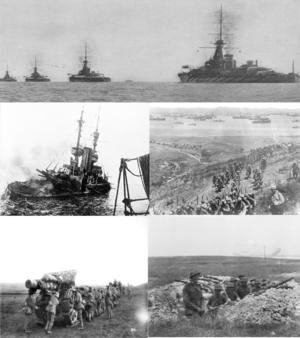Belfro-Mutulese war of 1911
| Belfro-Mutulese War of 1911 | |||||||
|---|---|---|---|---|---|---|---|
 Clockwise from the top : Belfrasian patrol before the Battle of Kalinagos, Belfrasian landing in Ekab, Belfrasian soldier in a trench during the Battle of Eunos, Mutulese artillery during the Xuman Campaign , Mutulese warship "Jukaj" after the Attack on Zuz Peten | |||||||
| |||||||
| Belligerents | |||||||
|
Template:Country data Hachawaya |
| ||||||
| Strength | |||||||
|
Template:Country data Hachawaya 200,000 |
| ||||||
| Casualties and losses | |||||||
|
Military dead: some numbers Civilians dead: |
Military dead: some numbers Civilians dead: | ||||||
The Belfro-Mutulese War of 1911, also known as the Oxi-Norumbrian War or the Hachahatak War was a millitary conflict that opposed the Belfrasian Federation, the State of Eunos, also known as Hachawaya, and the Mutul, that lasted from 1911 to 1915. The war was centered around the Kalinagos Strait, and the Kayamuca Sea, with fighting taking place in the Belfrasians states of Eunos, Agonon and Igo, and the Mutuleses territories of the Kalinagos Islands, K’uzamel Island, and the Xuman Peninsula.
The war started following the retractation of the State of Eunos from the Treaty of the Federation, declaring itself as an independent, sovereign, nation taking the name of Hachawaya. The new state was recognized by the Mutul, which escalated the conflict between the Divine Kingdom and Belfras, up until the attack without warning on Zuz peten by the Belfrasian Navy, which mark the beginning of the war.
Background
The Treaty of the Federation
The return of the Vespanian Fleet
In 1891, the Treaty of Kumar marked the end of the Mutulese presence in Ochran by recognizing Benaajab as an independent country. With this, the Mutulese Vespanian Fleet returned to the Mutul. The fleet came to reinforce the Mutuleses naval forces already present in Eastern Makria and the Kayamuca Sea, and the Divine Kingdom had now a fleet, on paper, able to match the Latins/Belfrasians Navy, or at the very least, contest their hegemony over the Kayamuca Sea.
This raised suspicion among the Belfrasians States, and the fear of the “southern threat” returned all the more that at the same time, divisions started to appear among the States on the question of the Act of the Federation.
Hachahatak Autonomous Movement
Despite the celebrations surrounding the “Treaty of the Federation”, some voices started to emerge against the text as it was signed. The “Southern States” like Eunos, Kistos, and Igo disagreed with some of the compromises made during the negociations.
These disagreements between a perceived “north” and “south” only worsened as time went on. Multiple parties started to appear in each of the southern states and even beyond, fighting to revoke the Treaty, claiming the Federation to be a scam orchestrated by Thesalonica to gain even more power over the other States.
Arms race
For all of these reasons and more, both Belfras and the Mutul found themselves in the middle of deep restructuration of their territories, institutions, and military. The Belfrasian Federation, which was animated by the idea of becoming the “Second Hemisphere of the Latin Empire”, fully believed that whoever controlled the sea also controlled the world. The Federation Navy was founded, alongside the marines, 5 years before the Federal Army, which was still a collection of states militaries with no connected hierarchy. As a result, the Federation wished for its Navy to be at least the equal of the Latium’s Imperial Navy and superior to all possible competitors in the Kayamuca Sea.
This clearly defined goal provoked the ire of the Federation’s neighbors, notably of the Mutul which, even if it had a military budget on par with Belfras, had to be present in more theatres than just the Kayamuca Sea. The return of the Vespanian fleet changed the balance, and both country had equal numbers and maritime presence in the same regions.
The result was the Mutulo-Belfrasian arms race which modernized both countries militaries and navies, with ironclads being replaced by Dreadnoughts and large Battleships. The race de facto ended in 1910 with a draw, as neither managed to take the edge on their rival, but truly ingrained in the public and political consciousness of the time the idea that the two nations were mortal enemies. Studies of the Norumbrian Crusades became an important part of the education of an entire generation of Belfrasians, while in the Mutul the memories of the Xuman Crusade were re-ignited along with the fear of the Christian Invader always hungry for more lands and souls. ”Suddently, both countries found themselves in the middle of a revanchist craze, from the higher echelons of the military to the most disadvantaged social classes, and no one was able to tell if it was 1260 or 1900...” wrote the journalist Arsen Gola in his memoirs of the period.
After two decades of military improvement and rising tensions, the war was no longer feared but desired. The very fact the arm race, by itself, amounted to nothing, led the Admiralty of the Belfrasian Federation to design bolder plans against the Mutul.